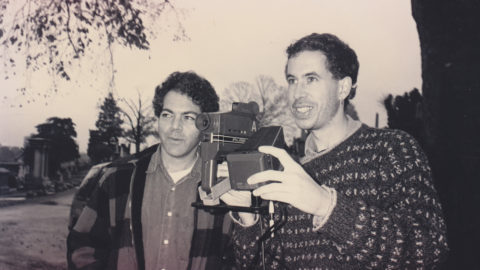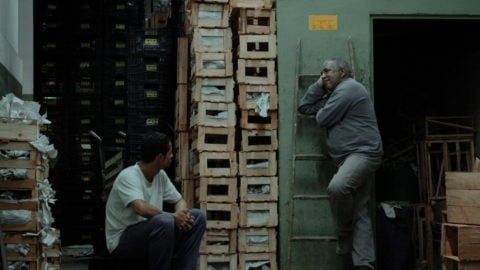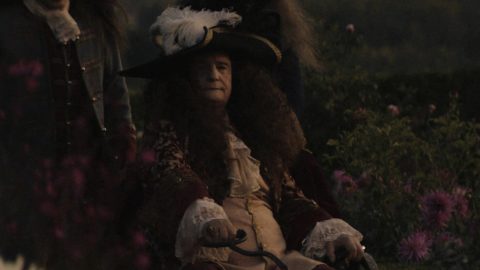Close Reading: Liberté
The Critics Academy, a program of Film at Lincoln Center and a venture of Film Comment, is a workshop for aspiring film writers, providing a valuable platform to launch their careers. Throughout the 57th New York Film Festival, Film Comment will be publishing work from young critics taking part in the program.
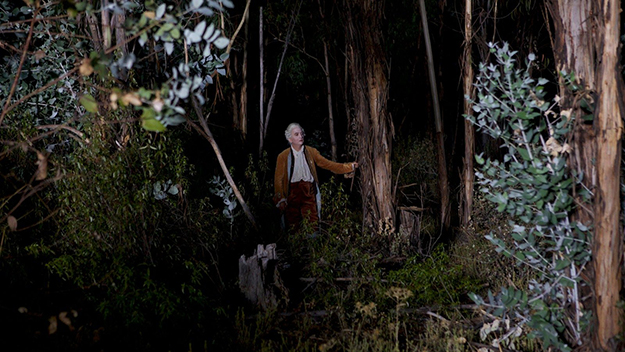
Images from Libterté (Albert Serra, 2019)
To others the universe seems decent because decent people have gelded eyes. That is why they fear lewdness. They are never frightened by the crowing of a rooster or when strolling under a starry heaven. In general people savor the “pleasures of the flesh” only on condition that they be insipid.
—Georges Bataille
In Catalonian director Albert Serra’s Liberté, the spectacle of sexual transgression dressed in powdered wigs, petticoats, and corsets brings to mind the Marquis de Sade and his The 120 Days of Sodom. Despite similarities to that foundational text, Serra’s latest rendezvous with ghosts of the past might feel bizarrely impotent compared to the forceful sexual exploits imagined by the namesake of all things cruel and erotic. This impotence is, in fact, the brilliance of Serra’s patient, frustrating, and frustrated new work, which, more than Sade or Salò, recalls the bawdy tableaux vivants of Pier Paolo Pasolini’s other masterwork, the Trilogy of Life, which possesses a macabre joie de vivre also at the heart of Liberté’s slow-burn political project.
Almost certainly the most sexually graphic entry in the filmmaker’s languorous body of work, Liberté keeps in step with his proven interests, be it the prolonged decay of the state and the body in The Death of Louis XIV, or the spiritual roaming of the three magi in Birdsong. Again, Serra forces us to slow down and suspend ourselves in the present moment. What’s been called by some commentators, and naturally Serra himself, the most idiosyncratic and unexpected film in competition at last spring’s Cannes film festival, Liberté follows what is essentially one extended nocturnal cruising session to probe the joys and pains of desire that often go unseen and unacknowledged by “gelded eyes.” The film is the third iteration of the concept, preceded by a stage version at Berlin’s Volksbühne in 2018, as well as a video installation in Madrid’s Reina Sofia earlier this year.
The action begins with a story: that of Robert Francois Damiens, a domestic servant drawn and quartered for the attempted murder of Louis XV, his fate here recounted in lasciviously vivid detail by the young, ghoul-eyed Duc de Wand (Baptise Pinteaux). Although not stated in the film, the year is 1774. Backlash against libertinage is in full swing, and exiled from the court of Louis XVI, Serra’s group of libertines, Wand among them, turn to the German Duc de Walchen (queer icon Helmut Berger) for safe haven. History inevitably colors the night; the impending whack of the guillotine amplifies a sense of urgency and taboo. A mess of palanquins set down in the dark Prussian forest “somewhere between Potsdam and Berlin” suggests a mobile campsite, ready to lift up and go at a moment’s notice. But as the moon rises, and the libertines scatter in search of warm bodies, these habitations evoke both the cramped eroticism of the confessional booth and the dingy quarters of bathroom stalls used for quick sex. Yet nothing here is particularly rushed; time, under the veil of night, is savored.

Dawn appears briefly at the beginning and end, but night is the film’s dominant mode, cradling its moon-pale libertines in velvet shadows, the setting dimly, delicately lit with dreamlike, chiaroscuro panache. Serra and cinematographer Artur Tort evoke the fleshy pastoral hedonism of Rococo painters Jean-Honoré Fragonard and François Boucher, supplemented by a surreal, nocturnal glow. In her new book, Night in French Libertine Fiction, Marine Ganofsky writes about the inception of nighttime as an erotic zone in 18th-century libertine fiction, and how, once liberated from the trappings of horror and notions of the unknown, it could give expression to or provide cover for the consummation of hidden fantasies. The night, in other words, promotes freedom. Serra’s past work evinces an ongoing interest in the symbolic power of night—The Story of My Death (2013), for instance, succumbs to swathes of darkness over time to suggest a cultural shift. Speaking at a Q&A for one New York Film Festival screening of Liberté, Serra elaborated on his use of night logic: “You consume the night and the following night, you start from zero. There’s no progress and no one will be judged. There’s no spending or earning, personally or morally. It’s the arbitrary side of desire.”
Moving slowly and deliberately, the group of about a dozen or so men and women dip in and out of palanquins, slinking and peeking through forest shadows to make contact or admire others from a distance. The mélange of varied individuals—servants and aristocrats, fat and thin, handsome and ugly—suggests an indifference to hierarchies of identity and personal-preference-tailored attraction. Instead libertinage is posited as chaotic, more interested in power and the delights of restraint. For the most part, Serra’s casting—a mix of professional actors and the unknown and untrained, some lifted from Facebook call-outs—conveys this desired democratic effect (though the suspiciously homogenous selection of women might ironically betray Serra’s own lack of imagination).
Shooting again in long takes and with three cameras, Serra’s habitual approach suits the film’s libidinal economy, accentuating the exchange of glances and gazing, the sense of distraction and frustration in a night of pleasure seeking. More shocking acts of BDSM and piss play are punctuated by leering profiles of onlookers, themselves stunned with voyeuristic pleasure or silently rubbing themselves. These provocations comprise very nearly the entire runtime (two hours and 12 minutes). Though counter to expectations of similarly transgressive fare—Salò’s death-drive anesthetization, the genital close-ups of Gaspar Noé’s Love, or the assembly-style sex scenes and ass-shots of Abdellatif Kechiche’s Mektoub series—Liberté is no joyride. For Serra, sex is languorous; even the tougher kind that draws blood and leaves bruises can be generated by mere whimsy, and accompanied by inertia.
The thrills of cinema premised on the shock and awe of progressively mounting taboo, sex, blood, and violence are often set into convention, courting an automatic sense of “what’s next” anticipation to grip audiences blindly feeling their way through the film. A first screening of Liberté inevitably generates feelings of pent-up expectations over what titillations might follow, and watching the film with an uninitiated crowd doubles as a game of keeping tabs on what exactly will push people over the edge and prematurely out the door. But part of the reason why some might emerge feeling swindled perhaps has less to do with the film’s depravity as such, than its disinterest in pushing depravity into unknown or particularly novel territory. Serra, for better or worse, isn’t interested in the limits of transgression here. On second watch, knowing full well the events slated to unfold, I noticed a certain aimlessness and haphazard quality to the erotic whims on display, which by modern standards register as relatively muted next to the work of flashier provocateurs.
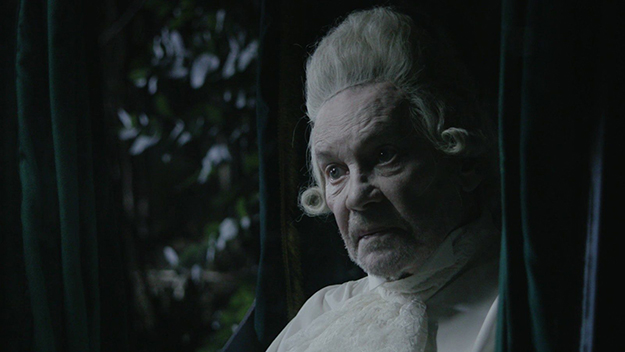
As the film mounts toward its climactic pissing scene, sexual climax is ironically, conspicuously absent. One of the women (Illiana Zabeth) berates her then-partner for his inability to sustain an erection; the same dysfunction comes in the midst of another person’s fantasy fulfillment, his penis oddly flaccid as he enjoys golden showers. These hiccups are at once an expression of Serra’s interest in decay and decrepitude, and the anguish and metaphysical frustration that belies the film’s understanding of desire as necessarily unfulfilled. One of the men, played by Serra regular Marc Susini, explains that sustaining an erection is secondary—it’s “what’s inside that matters.”
Serra’s cinematic language here entertains just such an unorthodox sexuality, one that indulges in erotic exchange beyond the physical: that of looking and being looked at, of language and its inherent impotence, and of speaking and “the organs of hearing,” which Sade himself famously praised in his preface to The 120 Days of Sodom as “the most flattering and those whose impressions are the liveliest.” For all the inaction and obscured drama, Liberté prevails as a soundscape of delicately suggestive susurrus—crickets chirping, soft moaning, rustling leaves and branches. Wand, the most talkative member in a group of mostly grunters and moaners, has what are perhaps the film’s most evocative moments in his monologue of fantasies never visualized in the film itself. Ideas of bestiality and fecal transference, preserved and out of reach in the conceptual amber of words, are more provocative precisely because they’re unattainable.
The pleasurable hurt of incomplete satisfaction brings to mind one of the most frustrating, desperate films about longing: Krzysztof Kieślowski’s A Short Film About Love, in which a lovelorn Tomek orgasms when grazing his hands up his beloved Magda’s thighs. If the unspoken, the partially acted upon, and the completely untouched can function as erotic stimuli, what does this say about the fickle nature of desire? About the conditions for its manifestation? What’s better: the cheek-gnawing, lip-tearing dissatisfaction of the unfulfilled sex act or the orgasm that suffocates and brings it all to a rearing halt? Serra has long demonstrated an interest in the porous boundaries between life and death; how one cannot exist without the other. Liberté plays with both in various proportions, neutralizing and dampening bouts of raw vitality by the bitter and disappointing limits of mortality. Desire thrives in the bleak conditions of its negation, and Serra would have it no other way.
Beatrice Loayza is a film and culture writer based in Washington, D.C.



